Interested in Instrumentation?
Get Instrumentation articles, news and videos right in your inbox! Sign up now.
Instrumentation + Get AlertsIn recent years, TOC has steadily gained in importance in both wastewater and drinking water analysis. In relationship to COD, TOC provides specific information about the type and origin of organic loads in wastewater.
In drinking water production TOC is an important measurement for monitoring precursors to disinfection byproducts. TOC monitoring and removal are regulated by the U.S. EPA. Hach TOC Method 10267 is approved for measuring TOC in drinking water.
Advances have also been made in TOC analysis: no longer is a major investment required, either financially or in terms of equipment. Reliable and cost-effective TOC measurements are possible with the Hach TNTplus Vial Test System.
What does TOC tell us?
Alongside or in association with COD and BOD5, TOC is an important sum parameter for assessing the organic load of water. As all organic carbon compounds are determined and specified in terms of carbon mass, TOC is an exactly definable absolute quantity and is directly measurable (unit: mg/L C).
Wastewater applications frequently measure organic loading via COD. Neither COD nor TOC on their own shed light on the oxidizability of the measured carbon or the amount of oxygen needed for its biodegradation. However, the ratio of COD to TOC provides important information about the presence of certain organic compounds (alcohols, proteins, etc.). If this ratio changes, for example in the inflow of a sewage treatment plant, conclusions can be drawn immediately about the causes, and the possible effects on biological processes in the sewage treatment plant.
Drinking water producers monitor TOC as an indicator of potential DBP formation. The majority of organic material in source waters is from natural organic matter. Natural organic matter reacts with common disinfectants such as chlorine and chloramines to form DBP. Removal of TOC may be mandated as a means of minimizing DBPs.
The TOC is determined directly with just one measurement after the inorganic carbon has been completely expelled from the sample (acidification plus purging). Especially suitable for samples with:
- A TIC content that is much higher than their TOC content
- A very low TIC content
- A low TOC content
TOC TNTplus vial tests
Vial tests are the simplest and most cost-effective TOC measurement option. The chemicals and photometer are factory-calibrated and are therefore ready for immediate use.
A wet chemical oxidative digestion is carried out, followed by photometric determination of the liberated carbon dioxide. The CO2 passes from a digestion vial through a gas-permeable membrane and into an indicator vial. The resulting color change in the indicator is evaluated photometrically.
A significant advantage of this method is that even turbid, particle containing and colored samples can be analyzed without difficulty, as only the color change in the indicator vial is measured.
The purging method requires the inorganic carbon to be removed from the sample before the digestion is carried out. This is accomplished via the TOC-X5 shaker. The sample is simply pipetted into the digestion vial, and the open vial is positioned in the shaker. The combination of shaker and fan drives all the TIC out of up to eight samples simultaneously within just five minutes. The cap is then screwed onto the indicator vial, and the TOC digestion in the reactor can begin.
The shaker procedure saves time and is very easy and reliable from the point of view of handling.
- The correct amounts of all reagents are already present in the digestion vial.
- Analysis accessories do not need to be rinsed with TOC-free water.
- The two practical measuring ranges cover carbon concentrations from 1.5 to 300 mg/L. Homogenized samples can usually be analyzed immediately without any need for time-consuming dilution, which is also a potential source of error.
For more information on wastewater testing and equipment, visit www.hach.com.





